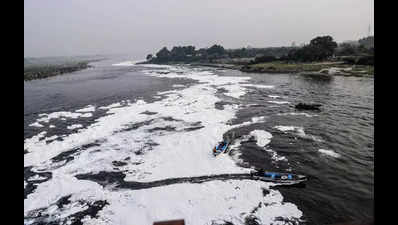NEW DELHI: A recent analysis based on samples collected in February has revealed a decline in the Yamuna’s water quality, with the river recording a significant rise in faecal coliform.
The faecal coliform (FC) concentration was 160 lakh/100 ml at Asgarpur, where Yamuna exits the city, compared to 79 lakh in Jan. This is the highest FC measurement at Asgarpur since Dec 2020, when it was 120 crore/100 ml, suggesting substantial sewage discharge into the river. FC should not exceed 2,500 units, with an ideal limit of 500 units for the river to remain healthy.
Not only Asgarpur, FC levels remained high at other locations too — 54 lakh at ISBT bridge and 43 lakh at ITO bridge.
According to water quality reports, in any given month, the river enters Delhi via Palla with enough dissolved oxygen (DO) to support life. However, by the time it crosses Signature Bridge, it begins to rot and transform into an untreated drain with stinking murky water, no aquatic life, and stagnant at several places.
DO, which should be 5 mg/l or above in the river, met the standard at Palla and Wazirabad but was nil at six locations — ISBT bridge, ITO bridge, Nizamuddin bridge, Okhla barrage, Agra canal and Asgarpur.
Similarly, the biological oxygen demand (BOD) levels were not met at any locations. At 72 mg/l, BOD levels were the highest at Asgarpur, exceeding the safe limit by 24 times.
Bhim Singh Rawat, a Yamuna activist and associate coordinator of South Asia Network on Dams, Rivers and People, said the alarming situation of DO, BOD and FC at all eight monitoring sites clearly reveals that untreated effluents, both domestic and industrial, are being discharged in huge volumes into the Yamuna through drains all along the course of the river in the city.
“Secondly, this indicates the existing STPs haven’t been functioning at prescribed norms. Thirdly, it reinforces the utmost requirement of adequate flows in the river to dilute the worsening pollution levels,” said Rawat.
According to activist Diwan Singh, “Shahdara drain, which also receives wastewater from Ghazipur drain, is one of the biggest culprits that carries much of the untreated sewage and industrial effluents in it, not just from Delhi, but also from UP. The high quantity of untreated industrial effluents entering the sewage drains and being trapped by STPs makes the latter non-compliant.”
Activist Pankaj Kumar, who uses the name ‘Earth Warrior’ on social media, said, “FC at Asgarpur is the highest in at least four years and significantly high at ISBT and ITO bridges. The high quantity of FC shows STPs aren’t functioning properly. Even the latest water quality report of STPs shows out of 36 STPs in Delhi, 16 are not meeting the prescribed standard.”




